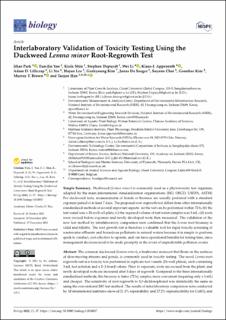| dc.contributor.author | Park, Jihae | |
| dc.contributor.author | Yoo, Eun-Jin | |
| dc.contributor.author | Shin, Kisik | |
| dc.contributor.author | Depuydt, Stephen | |
| dc.contributor.author | Li, Wei | |
| dc.contributor.author | Appenroth, Klaus-J. | |
| dc.contributor.author | Lillicrap, Adam D. | |
| dc.contributor.author | Xie, Li | |
| dc.contributor.author | Lee, Hojun | |
| dc.contributor.author | Kim, Geehyoung | |
| dc.contributor.author | De Saeger, Jonas | |
| dc.contributor.author | Choi, Soyeon | |
| dc.contributor.author | Kim, Geonhee | |
| dc.contributor.author | Brown, Murray T. | |
| dc.contributor.author | Han, Taejun | |
| dc.date.accessioned | 2022-03-11T12:15:39Z | |
| dc.date.available | 2022-03-11T12:15:39Z | |
| dc.date.created | 2022-02-14T10:49:13Z | |
| dc.date.issued | 2022 | |
| dc.identifier.citation | Biology (Basel). 2021, 11 (1), 37. | en_US |
| dc.identifier.issn | 2079-7737 | |
| dc.identifier.uri | https://hdl.handle.net/11250/2984638 | |
| dc.description.abstract | The common duckweed (Lemna minor), a freshwater monocot that floats on the surfaces of slow-moving streams and ponds, is commonly used in toxicity testing. The novel Lemna root- regrowth test is a toxicity test performed in replicate test vessels (24-well plates), each containing 3 mL test solution and a 2–3 frond colony. Prior to exposure, roots are excised from the plant, and newly developed roots are measured after 3 days of regrowth. Compared to the three internationally standardized methods, this bioassay is faster (72 h), simpler, more convenient (requiring only a 3-mL) and cheaper. The sensitivity of root regrowth to 3,5-dichlorophenol was statistically the same as using the conventional ISO test method. The results of interlaboratory comparison tests conducted by 10 international institutes showed 21.3% repeatability and 27.2% reproducibility for CuSO4 and 21.28% repeatability and 18.6% reproducibility for wastewater. These validity criteria are well within the generally accepted levels of <30% to 40%, confirming that this test method is acceptable as a standardized biological test and can be used as a regulatory tool. The Lemna root regrowth test complements the lengthier conventional protocols and is suitable for rapid screening of wastewater and priority substances spikes in natural waters. | en_US |
| dc.language.iso | eng | en_US |
| dc.publisher | MDPI | en_US |
| dc.rights | Navngivelse 4.0 Internasjonal | * |
| dc.rights.uri | http://creativecommons.org/licenses/by/4.0/deed.no | * |
| dc.title | Interlaboratory Validation of Toxicity Testing Using the Duckweed Lemna minor Root-Regrowth Test | en_US |
| dc.type | Peer reviewed | en_US |
| dc.type | Journal article | en_US |
| dc.description.version | publishedVersion | en_US |
| dc.rights.holder | © 2021 The Authors | en_US |
| dc.source.pagenumber | 14 | en_US |
| dc.source.volume | 11 | en_US |
| dc.source.journal | Biology (Basel) | en_US |
| dc.source.issue | 1 | en_US |
| dc.identifier.doi | 10.3390/biology11010037 | |
| dc.identifier.cristin | 2001201 | |
| dc.relation.project | Norsk institutt for vannforskning: NCTP | en_US |
| dc.relation.project | Norges forskningsråd: 268294 | en_US |
| dc.relation.project | Norges forskningsråd: 223268 | en_US |
| dc.source.articlenumber | 37 | en_US |
| cristin.ispublished | true | |
| cristin.fulltext | original | |
| cristin.qualitycode | 1 | |

